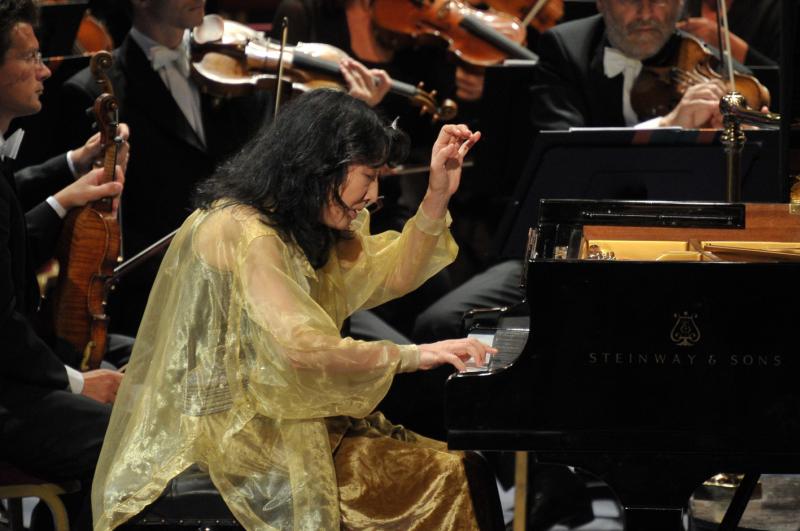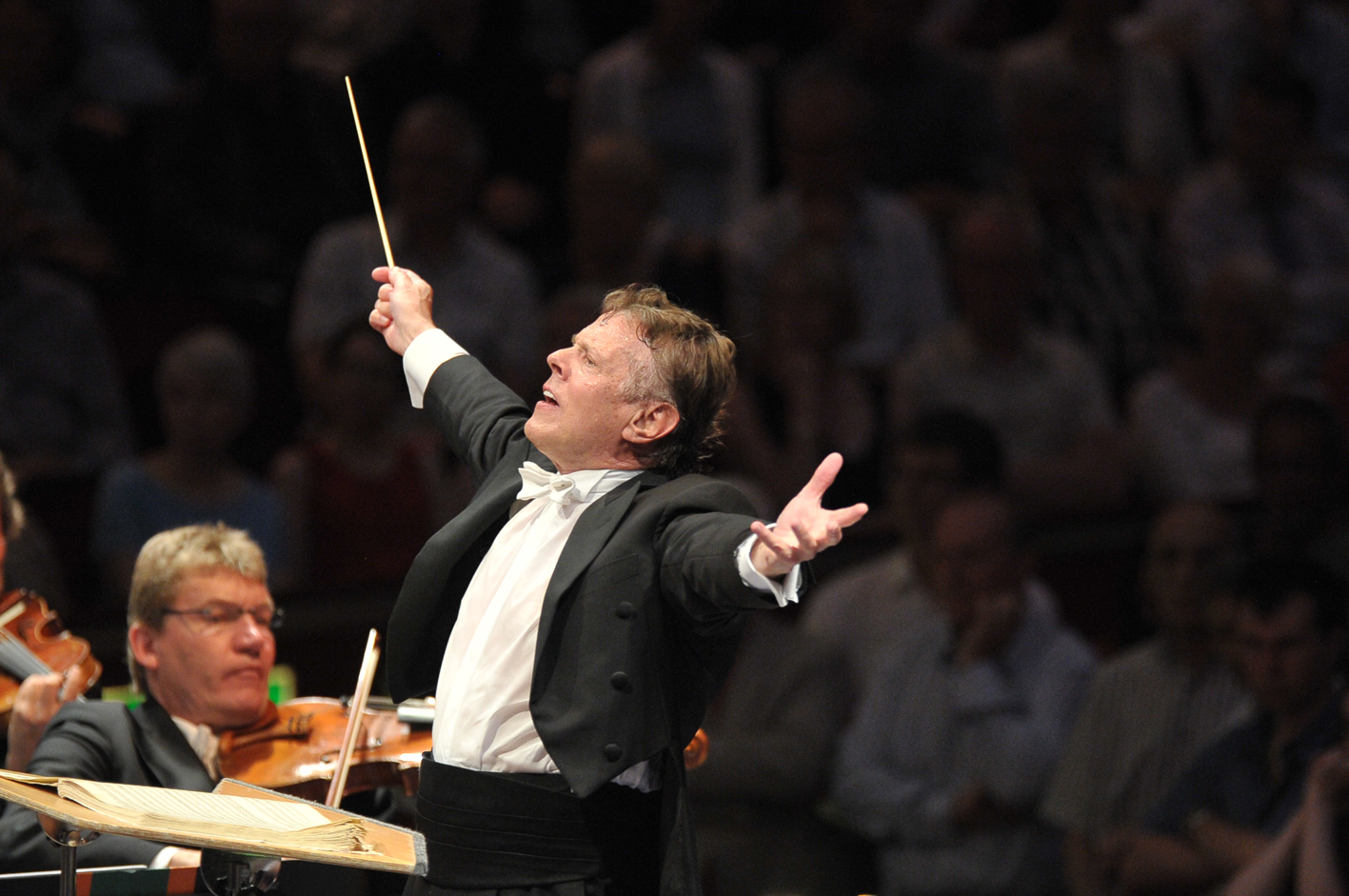Prom 33: Uchida, Bavarian Radio Symphony Orchestra, Jansons | reviews, news & interviews
Prom 33: Uchida, Bavarian Radio Symphony Orchestra, Jansons
Prom 33: Uchida, Bavarian Radio Symphony Orchestra, Jansons
Truly great pianism followed by rather polite orchestral playing from the Bavarians

Precious few musicians can instill such a sense of intimacy into their playing as to have us believing that the Royal Albert Hall is the Wigmore Hall and that their performance is for an audience of one and not six thousand. Mitsuko Uchida is among the select few.
Perhaps there were a few more finger slips in this performance than we are accustomed to with Uchida - the finale especially seemed marginally to tire despite Jansons’ vigorous attentions - but there was more than enough here to excite the imagination, the articulation spry and meaningful, the contrasts between action and repose vividly drawn, and a first movement cadenza where a world of expression seemed to dissolve into the most expectant and luminous trills imaginable.
They emerged again, with unexpected menace, in the climactic solo passage of the slow movement, the start of which was sternly, weightily, announced by articulate Bavarian cellos and string basses. Uchida was truly in her own world here, unheeding of those string declamations (a stroke of unparalleled genius from Beethoven), and the arrival of the keyboard’s rapt melody sounded transfigured. What a truly great pianist she is. And as if to emphatically reinforce that view there was her encore - the ravishing trill-festooned Sarabande from Bach’s Fifth French Suite in G - where I began to wonder if I had ever heard a more beautiful piece of piano playing.
 The main event for Jansons (pictured right) and his cultured Bavarians was that much-loved showpiece for the great and the good of international orchestras - Berlioz’ Symphonie fantastique. Jansons and his players caught the rapture, the fragrance, the headiness of the music, their homogenous blend wonderfully anchored in panting, seductive string basses with such star turns as the first oboe and first bassoon sounding eminently French in sensibility. Effective too was Jansons’ response to those quirky dynamic contrasts - subito piano/ subito forte - where the sound must suddenly evaporate and then with equal suddenness be reinstated and redoubled in intensity. The Scene at the Ball was elegantly turned and intoxicating, the scene in the country well managed for its “special effects” - oboe magically replying to cor anglais from offstage and the distant thunder of multiple timpanists forming ominous chord clusters.
The main event for Jansons (pictured right) and his cultured Bavarians was that much-loved showpiece for the great and the good of international orchestras - Berlioz’ Symphonie fantastique. Jansons and his players caught the rapture, the fragrance, the headiness of the music, their homogenous blend wonderfully anchored in panting, seductive string basses with such star turns as the first oboe and first bassoon sounding eminently French in sensibility. Effective too was Jansons’ response to those quirky dynamic contrasts - subito piano/ subito forte - where the sound must suddenly evaporate and then with equal suddenness be reinstated and redoubled in intensity. The Scene at the Ball was elegantly turned and intoxicating, the scene in the country well managed for its “special effects” - oboe magically replying to cor anglais from offstage and the distant thunder of multiple timpanists forming ominous chord clusters.
But as the hallucinations became more grisly beneath the scaffold and amidst the cavorting hags of the Witches’ Sabbath I began to want more edge and more sheer brilliance from the sound, to say nothing of a degree or two more grotesqueness in the characterisation so that those fruity bassoons were less inviting, more malevolent, and the trumpets and growling trombones more brashly celebratory. Spooky glissandi in oboes and flutes and horn (later hand-stopped in grimace) caught the humour of the finale but the increasing rampant “Dies irae” was frankly a bit tame and it was only when Jansons did his usual trick of ratcheting up the tempo for the pay-off that the excitement really kicked in.
The encore took me and most everybody else by surprise - a weird and wonderful gypsy spoof from that master cartoonist, Gyorgy Ligeti - the fourth movement of his Concert Romanesc - which picked up deliciously on Berlioz‘ sense of parody and got full marks for originality even if it did need dirtying up a bit more.
rating
Share this article
The future of Arts Journalism
You can stop theartsdesk.com closing!
We urgently need financing to survive. Our fundraising drive has thus far raised £49,000 but we need to reach £100,000 or we will be forced to close. Please contribute here: https://gofund.me/c3f6033d
And if you can forward this information to anyone who might assist, we’d be grateful.

Subscribe to theartsdesk.com
Thank you for continuing to read our work on theartsdesk.com. For unlimited access to every article in its entirety, including our archive of more than 15,000 pieces, we're asking for £5 per month or £40 per year. We feel it's a very good deal, and hope you do too.
To take a subscription now simply click here.
And if you're looking for that extra gift for a friend or family member, why not treat them to a theartsdesk.com gift subscription?
more Classical music
 Kilsby, Parkes, Sinfonia of London, Wilson, Barbican review - string things zing and sing in expert hands
British masterpieces for strings plus other-worldly tenor and horn - and a muscular rarity
Kilsby, Parkes, Sinfonia of London, Wilson, Barbican review - string things zing and sing in expert hands
British masterpieces for strings plus other-worldly tenor and horn - and a muscular rarity
 From Historical to Hip-Hop, Classically Black Music Festival, Kings Place review - a cluster of impressive stars for the future
From quasi-Mozartian elegance to the gritty humour of a kitchen inspection
From Historical to Hip-Hop, Classically Black Music Festival, Kings Place review - a cluster of impressive stars for the future
From quasi-Mozartian elegance to the gritty humour of a kitchen inspection
 Shibe, LSO, Adès, Barbican review - gaudy and glorious new music alongside serene Sibelius
Adès’s passion makes persuasive case for the music he loves, both new and old
Shibe, LSO, Adès, Barbican review - gaudy and glorious new music alongside serene Sibelius
Adès’s passion makes persuasive case for the music he loves, both new and old
 Anja Mittermüller, Richard Fu, Wigmore Hall review - a glorious hall debut
The Austrian mezzo shines - at the age of 22
Anja Mittermüller, Richard Fu, Wigmore Hall review - a glorious hall debut
The Austrian mezzo shines - at the age of 22
 First Person: clarinettist Oliver Pashley on the new horizons of The Hermes Experiment's latest album
Compositions by members of this unusual quartet feature for the first time
First Person: clarinettist Oliver Pashley on the new horizons of The Hermes Experiment's latest album
Compositions by members of this unusual quartet feature for the first time
 Gesualdo Passione, Les Arts Florissants, Amala Dior Company, Barbican review - inspired collaboration excavates the music's humanity
At times it was like watching an anarchic religious procession
Gesualdo Passione, Les Arts Florissants, Amala Dior Company, Barbican review - inspired collaboration excavates the music's humanity
At times it was like watching an anarchic religious procession
 Classical CDs: Camels, concrete and cabaret
An influential American composer's 90th birthday box, plus British piano concertos and a father-and-son duo
Classical CDs: Camels, concrete and cabaret
An influential American composer's 90th birthday box, plus British piano concertos and a father-and-son duo
 Cockerham, Manchester Camerata, Sheen, Martin Harris Centre, Manchester review - re-enacting the dawn of modernism
Two UK premieres added to three miniatures from a seminal event of January 1914
Cockerham, Manchester Camerata, Sheen, Martin Harris Centre, Manchester review - re-enacting the dawn of modernism
Two UK premieres added to three miniatures from a seminal event of January 1914
 Kempf, Brno Philharmonic, Davies, Bridgewater Hall, Manchester review - European tradition meets American jazz
Bouncing Czechs enjoy their Gershwin and Brubeck alongside Janáček and Dvořák
Kempf, Brno Philharmonic, Davies, Bridgewater Hall, Manchester review - European tradition meets American jazz
Bouncing Czechs enjoy their Gershwin and Brubeck alongside Janáček and Dvořák
 Solomon, OAE, Butt, QEH review - daft Biblical whitewashing with great choruses
Even a top soprano and mezzo can’t make this Handel paean wholly convincing
Solomon, OAE, Butt, QEH review - daft Biblical whitewashing with great choruses
Even a top soprano and mezzo can’t make this Handel paean wholly convincing
 Two-Piano Gala, Kings Place review - shining constellations
London Piano Festival curators and illustrious friends entertain and enlighten
Two-Piano Gala, Kings Place review - shining constellations
London Piano Festival curators and illustrious friends entertain and enlighten
 Echo Vocal Ensemble, Latto, Union Chapel review - eclectic choral programme garlanded with dance
Beautiful singing at the heart of an imaginative and stylistically varied concert
Echo Vocal Ensemble, Latto, Union Chapel review - eclectic choral programme garlanded with dance
Beautiful singing at the heart of an imaginative and stylistically varied concert

Add comment